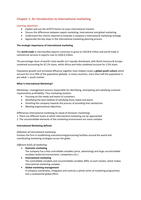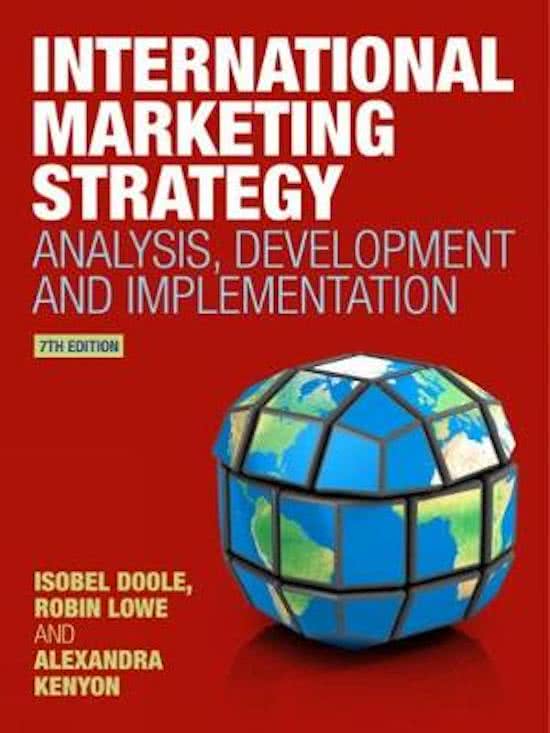Chapter 1: An introduction to international marketing
Learning objectives:
Explain and use the SLEPTS factors to asses international markets
Discuss the differences between export marketing, international and global marketing
Understand the criteria required to evaluate a company’s international marketing strategy
Appreciate the key steps in the international marketing planning process
The strategic importance of international marketing
The world trade in merchandise exports continues to grow to US$18.8 trillion and world trade in
commercial services in exports rose to US$4.6 trillion.
The percentage share of world’s total wealth isn’t equally distributed, with North America & Europe
combined accounting for 67,1% share, whilst Africa and India combined account for 2,5% share.
Population growth and increased affluence together have helped create a global youth culture which
account for circa 30% of the population globally. In many countries, more than half the population is
pre-adult -> youth market.
What is International Marketing?
Marketing = management process responsible for identifying, anticipating and satisfying customer
requirements profitability. Thus marketing involves:
Focusing on the needs and wants of customers
Identifying the best method of satisfying those needs and wants
Orienting the company towards the process of providing that satisfaction
Meeting organizational objectives
Differences International marketing (in stead of Domestic marketing):
1. There are different levels at which international marketing can be approached
2. The uncontrollable elements of the marketing environment are more complex
International Marketing defined
Definition of international marketing:
Involves the firm in establishing manufacturing/processing facilities around the world and
coordinating marketing strategies across the globe.
Different levels of marketing:
Domestic marketing
The company has a few controllable variables (price, advertising) and large uncontrollable
variables (external environment, competitors etc.)
International marketing
The controllable variabels and uncontrollable variables differ at each market, which makes
international marketing complex.
Global marketing management
A company coordinates, integrates and controls a whole series of marketing programmes
into a susbstantial global effort.
,International marketing could be:
Export marketing
The firm markets its goods and/or services across national/political boundaries.
International marketing
The marketing activities include activities, interests or operations in more than one country
and where there is some kind of influence or control of marketing activities from outside the
country in which the goods or services will actually be sold.
Global marketing
The whole organization focuses on the selection and exploitation of global marketing
opportunities and marshals recources around the globe with the objective of achieving a
global competitive advantage.
The key difference between domestic marketing and marketing on a international scale =
the multidimensionality and complexity of the many foreign country markets a company may
operate in. An international manager needs a knowledge and awareness of these complexities and
the implications they have for international marketing management.
International marketing environment
The SLEPTS factors describe the external marketing environment.
SLEPTS:
S = Social
L = Legal
E = Economic
P = Political
T = Technological
S = Sustainable
Social/cultural factors
‐ Social/cultural difference between countries are immense
‐ Companies will have to adjust to succeed
‐ Cultural differences involve language, religions and habits (India – McDonalds)
Cultural paradoxes: for example in Asia, the Middle East, Africa and Latin America, there is evidence
both for the westernization of tastes and the assertion of ethnic, religious and cultural differences.
Legal environment
‐ A company is not only bound by laws of its home country but also of Europe and its host
country.
‐ The laws involved in international marketing can be divided in three dimensions.
1. Local domestic laws: These are all different per country!, use experts on separate
legal systems.
2. International law: Cover laws for multiple regions, like IMP, patents, trademarks,
European Union is example of regional economic grouping.
3. Domestic laws in the home country: Could limit the free export, country must act
and abide its national laws in all activities.
, Economic environment
‐ Important to have understanding of economic developments
‐ Economics are divided in:
o Developed countries: (EU, North America, Japan)
o Emerging economies: (Brazil, Russia, India, China. (Demand in technology like
cars an phones is growing, rapidly developing) Usually wealth is divided with
a poor and a rich part of society.
o Less developed/underdeveloped countries: Low GDP, limited amount
manufacturing activity, poor infrastructure.
‐ Currency movements and exchange rates should be tracked carefully
Political environment
‐ Government’s attitude and the freedom in which firms can operate. Unstable political
regimes expose foreign business to a variety of risks.
‐ Three main areas in which governments may take:
o Operational restrictions: Exchange controls, employment policies,
insistence on locally shared ownership and product requirements.
o Discriminatory restrictions: Tend to apply only on foreign usually
export/import restrictions from specific countries.
o Physical actions: Direct government interventions like confiscation
when not paying debts, forces takeovers and takeovers when
damage to country property is done.
Technological
‐ Major driving force in both international marketing and in the move towards a global
marketplace.
‐ Emerging economies are skipping parts in technological evolution.
‐ Internet playing huge role in international marketing (ordering online).
‐ Some countries have a technological/cultural paradox; don’t know their way around with
computers or the internet. There are also huge differences in costs of internet.
The demands of the world population are becoming bigger than the Earth and its resources can take.
Global economic wealth increases, but natural wealth and diversity decline. Companies start to
prioritize the way in which they express how environment friendly they are.
Differences between international and domestic marketing
There are many factors whitin the international environment which substantially increase the
challenge of international marketing. These can be summarized as follows:
‐ Culture: often diverse and multicultural markets
‐ Markets: widespread and sometimes fragmented
‐ Data: difficult to obtain and often expensive
‐ Politics: regimes vary in stability – political risk becomes an important variable
‐ Government: can be strong influence in regulating importers and foreign business ventures
‐ Economies: varying levels of development and varying and sometimes unstable currencies
‐ Finance: many differing finance systems and regulatory bodies
‐ Stakeholders: commercial, home country and host country
‐ Business: diverse rules, culturally influenced
‐ Control: difficult to control and coordinate across markets






